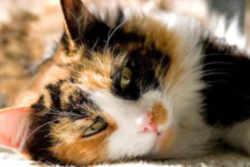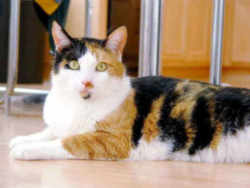Maryland State Cat
Calico Cat

(Felis catus)
Adopted on October 1, 2001
Effective October 1, 2001, the calico cat, (Felis catus,) became the official cat of Maryland (Chapter 194, Acts of 2001; Code State Government Article, sec. 13-317).
Its colors of orange, black, and white are shared with the Baltimore oriole (Maryland State bird) and the Baltimore Checkerspot butterfly (Maryland State insect).
So why is Maryland considering a state cat? And why calico?
Last spring, five then-fourth-grade students at Western Port Elementary School in Allegany County felt that it was time.
The five girls had studied how a bill becomes a law and visited the State House. There they learned another group of students proposed Maryland adopt an official dinosaur and succeeded, said Emily Weber, one of the students.
In April, Weber, January Mullen, Abigail Rawlings, Lexi Gentry and Molly Nelson wrote a letter to Kelly and asked him to propose a bill.
"Maryland has a state dog, and we thought that the colors of the calico cat would go with the Maryland state flag," said Mullen.
The ordinary calico cat would be elevated to official Maryland symbol if a new bill sponsored by Delegate Kevin Kelly, D-Allegany, is signed into law this session.
Maryland State Cat: Calico Cat

Calico cats are domestic cats with a spotted or parti-colored coat that is predominantly white, with patches of two other colors (often, the two other colors are orange tabby and black). Outside of North America, the pattern is more usually called tortoiseshell-and-white. In the province of Quebec, they are sometimes called chatte d'Espagne (French for '(female) cat of Spain'). Other names include tricolor cat, mi-ke (Japanese for 'triple fur'), and lapjeskat (Dutch for 'patches cat'); calicoes with diluted coloration have been called calimanco or clouded tiger. Occasionally, the tri-color calico coloration is combined with a tabby patterning. This calico patched tabby is called a caliby
Calico is not a breed of cat, but an unusual coloring occurring across many breeds, including Domestic Short-hair, Persian, and Manx. Virtually all calico cats are female; a male calico is a genetic anomaly and usually sterile. Producing calico kittens through selective breeding also is nearly impossible due to unpredictable actions of genes and chromosomes when cells multiply in a feline fetus.
A calico cat must be a tri-color, with its three colors in distinct patches, not mixed as in a tortoiseshell cat. Some breed standards specify what percentage of the body must be white; others allow tabby striping in the color patches. To be a true tri-color, a calico cat's colors must be: white; red or cream; and black, blue, chocolate, lilac, cinnamon, or fawn. The variations in color from red and black are caused by a gene which dilutes, or lightens up the basic color, and produces a dilute calico cat, most commonly with a coat of white, cream, and blue.
Notwithstanding the incredible permutations of patterns and colors, calico cats traditionally are believed to be bringers of good luck and even money, especially in Japan.
Maryland Law
The law designating the calico cat as the official Maryland state cat is found in the Maryland Statutes, Title 13, Section 13-317.
STATE GOVERNMMENT
TITLE 13. EMBLEMS; COMMEMORATIVE DAYS; MANUAL.
SUBTITLE 3. ADDITIONAL EMBLEMS; DESIGNATIONS
§13-317.
The calico cat is the State cat.
Taxonomic Hierarchy: Calico Cat
Kingdom: Animalia
Phylum: Chordata
Class: Mammalia
Order: Carnivora
Suborder: Feliformia
Family: Felidae
Subfamily: Felinae
Genus: Felis
Species: F. catus








